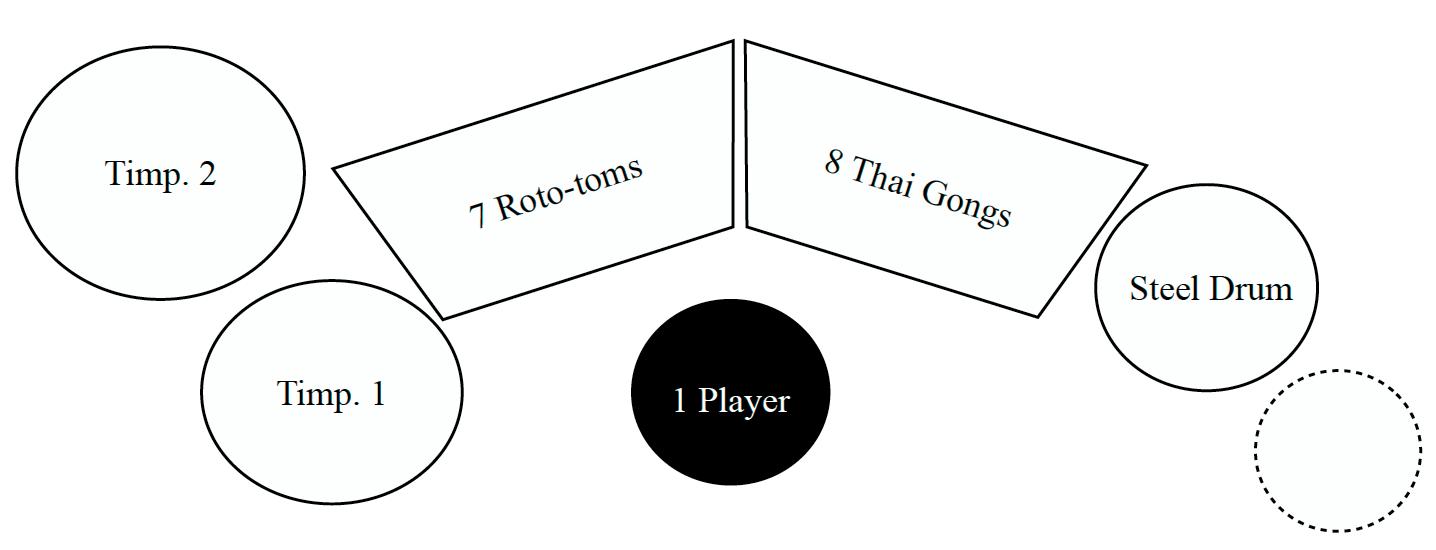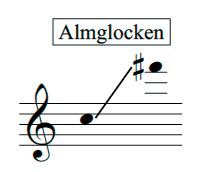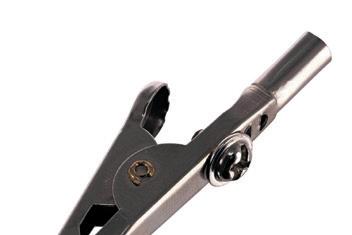Laurence Osborn TOMB!
for Strings, Percussion and Piano
INSTRUMENTATION
Percussion (1 player): Bass Drum, 2 Timpani (28" and 25")*, 7 Roto-toms*, 8 ai Gongs (not suspended), Steel Drum (tenor)*, Xylophone, Glockenspiel, Almglocken (w/ so , medium, hard beaters, drumsticks, ‘hot rod’ drumsticks)*, Castanets, Guiro, Vibraslap, Flexatone, Heavy Metal Chain*, Metal Bucket*
Piano w/ plastic plectrum, glass rods, 15 crocodile clips, 2 rubber mallets
6 Violins (w/ mutes, metal practice mutes, plastic plectrums)
3 Violas (w/ mutes, metal practice mutes)
2 Cellos (w/ mutes, metal practice mutes)
Double Bass
* see Percussion Setup
Duration 20 minutes
Co-commissioned by Norfolk and Norwich Festival Trust, Kings Place and Cheltenham Music Festival
World première performances given by 12 Ensemble and GBSR Duo at Norfolk and Norwich Festival (19 May 2023), Kings Place London (26 May 2023) and Cheltenham Music Festival (July 2023)
PERFORMANCE DIRECTIONS PERCUSSION
Percussion Setup: Timpani, Roto-toms, Thai Gongs, Steel Drum
e two timpani, seven roto-toms, eight thai gongs and steel drum are set up to function as an enormous composite instrument that can transition directly from the dark, drum-skin sounds of the timpani into metallic sound of the steel drum. e thai-gongs should be lain flat on a so , muffling surface (like a folded towel). ese instruments are to be played with a single set of sticks, so that the player can move between them easily. An extra steel drum can be used if necessary. e instruments should be set up like this:

Optional extra Steel Drum
e ranges and pitch-specifications of the instruments, together, are as follows:

Percussion Setup: Almglocken e almglocken should be lain flat on a surface like a table or trap tray. eir range is as follows:

Percussion Setup: Heavy Metal Chain
In b. 394 the percussion player is instructed to push a heavy metal chain into a bucket. is should be prepared with the chain coiled up on a surface and the bucket resting below. It should be set up in such a way that the chain, once pushed, can uncoil and fall freely into the bucket without the player touching it. It should be of a sufficient length to allow its uncoiling into the bucket to last roughly the duration of the arrow that starts at b. 394.
PERFORMANCE DIRECTIONS PIANO
Preparations
Sometimes the pianist is instructed to prepare the piano with glass rods or crocodile clips during the piece. is instruction is always accompanied by a box showing the range of the strings that should be prepared.
Crocodile Clips
At b. 263 the piano is prepared with metal crocodile clips, which are played with a mallet at bb. 278–306, 310–11, 314–15 and 317–19. e metal crocodile clips are ordinary ones that you might find in a hardware shop. ey should look a bit like this:


ere should be enough surface area on the top of each crocodile clip for it to be struck with a mallet. e crocodile clips are always attached to the strings of the piano in advance. en an individual clip (not the string) should be struck hard with the rubber mallet. e resulting sound, in the piano’s lower register, should be a resonant metallic boom that sounds the actual pitch of the string.
PERFORMANCE DIRECTIONS STRINGS
Glissandi
Glissandi should always leave the pitch almost immediately, lasting almost the whole duration of a given note.
Natural Harmonics
Almost all natural harmonics are indicated using a diamond notehead on the fingered pitch, the string specified, and the sounding pitch in brackets. However, some of the double-bass harmonics (such as the C naturals in the first section and the C sharp at b. 146) show the sounding pitch, but leave the fingering up to the player.
‘Antique’ Playing
Sometimes the expression direction antique is used. is indicates that the playing style, articulation and expression should follow the conventions of Baroque playing.
PROGRAMME NOTE
TOMB! is one continuous movement – a tombeau – lasting 20 minutes. It is, like any tombeau, written with great admiration and affection for older music. But it is also a piece that recognises and questions the morbid obsessions of heritage culture.
e tombeau is a strange custom, whereby a living artist honours a dead one by impersonating their voice. In her essay, Outside the Tomb, Carolyn Abbate recasts the tombeau as a mechanism that reanimates the voice of the dead artist from within, as if by magic. is beautiful and grotesque idea – of homage becoming necromancy – was the starting point for TOMB!
TOMB! contains many lifeless forms from musical history: fugues, gigues, passacaglias and things like that. All of these objects appear in a state of decomposition. Some are jolted into life, like frogs at the end of battery cables; others are worn like glove puppets; others rise slowly to their feet and lurch around, as if under a spell. Occasionally, things appear in their pure, calcified form: frozen, like fossils, at the moment of expiry.
Laurence Osborn 2022
o fmf o fp fp fmf o fmf o fp fp fmf o fmf o fp
